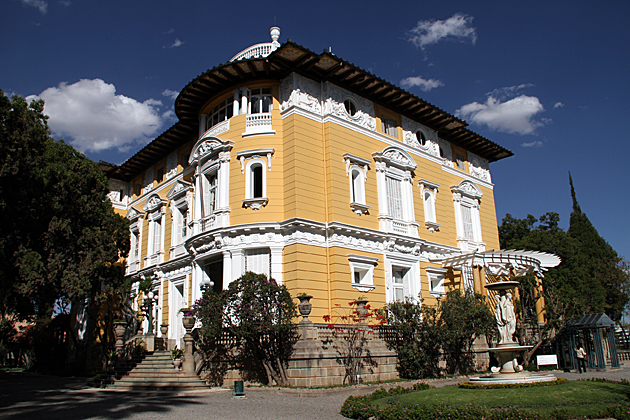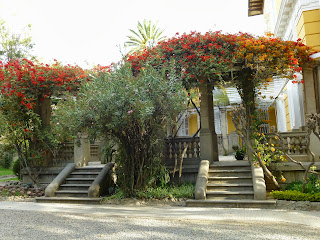A week or so ago we visited the Palacio Portales here in Cochabamba. It was the city mansion of "The Tin King", Simon Iturri Patiño. Some of you may remember the pictures I posted last March of his summer home. I told a little about his history then and I'm re-posting it here, in case anyone missed it last March and also because I think it's extremely interesting.
Simon Iturri Patiño was born 1 June 1862, died 20 April 1947 in Argentina and was buried in Cochabamba. I'll skip his early life. The important thing is that as a young adult, he started in mining with Compañía Hunanchaca de Bolivia, a silver company, and then with Fricke y Compañía. Patiño was assigned to collections for the store, and in 1894, he agreed to accept a deed of land in compromise for a $250 debt owed by a prospector. The deed turned out to be for the rocky side of a mountain, and Patiño was fired from his job for settling an account in exchange for a worthless piece of property. Legend has it that Patiño was forced to pay back the store from his own funds, and was stuck with his bad bargain.
The mountain turned out to be richer in minerals than anyone had imagined. Although the first several years of work yielded little, the turning point came in 1900 when Patiño located a very rich vein of tin, later called "La Salvadora" (The Savior). Over the next 10 years he built up the control of nearby mines and other important mines in Bolivia. By the 1920s he had also bought out Chilean interests in his mining company and went on to buy tin smelters in England and Germany. By the 1940s he controlled the international tin market and was one of the wealthiest men in the world, hence his "title" The Tin King (Rey del Estaño). During WWII he was considered to be one of the five wealthiest men in the world. How about that?!? And I'll bet you had never heard of him either.
What is really sad is that because of his health (he had a heart condition that could not survive the altitude in Bolivia), he had to live abroad for the latter half of his life. He never set foot in either the beautiful home he built in the country for his wife and children or the even more grandiose home he built within the city of Cochabamba. Apparently his family spent at least half the year in Bolivia, even though he had to stay in another country. His descendants (great-grand-children) still come to the country home in the summers. They live in the second story; the first story is a museum. His city home - Palacio Portales - has been given to the government and is a museum and cultural foundation.
Here are the pictures we took at Palacio Portales . . .
These are the entrance gates, taken from just inside. The Palacio is located north of downtown Cochabamba but still in a very busy semi-commercial area. The property covers between 5 and 10 acres.
This is looking down the side of the information building, toward the south boundary of the property.
This is a map of the property. You will note that the official name now is (translated): The Simon Patiño Cultural and Pedagogical Center.

There are pieces of statuary here and there on the grounds.
This is a copy of a famous Swiss statue.
In fact, as a preface (and/or warning) to the rest of the pictures,
here's some information from a website about the Palacio:
" . . . the gardens are beautifully arranged around the grounds, with Italian-style marble statues, ponds filled with goldfish and lily pads, and a wide variety of trees and vegetation. The gardens are lavish and ostentatious, but manage to remain tasteful — a tricky balancing act which the palace has trouble with.
Like the Recoleta Palace outside of Sucre, Patiño’s Palacio de Portales marries together a huge swath of styles, from French to Mozarabic to Italian. It’s called “Portales”, because of the massive ornamental doors which lead into the main receiving room. The mash-up of styles might have been impressive for a city unused to such extravagance, but nowadays it seems a bit ridiculous."
I didn't take this picture - I copied it from the above website because it was bigger - but as you can see from MY photo just below - it's the same angle, and a beautiful picture of the Palacio.

This is the entrance where the tour begins. Unfortunately - and this was a BIG disappointment - photos are not allowed inside, so I can't show you any of the luxurious rooms or furnishings. There is real silk on the walls, for instance - instead of wallpaper. There is a grand staircase that's about 5 feet wide. There are many rococo, Baroque paintings (like the Sistine chapel) as well as sculptures ranging from Roman and Greek to Renaissance. It really is what the above author called a "mish-mash". Our guide explained that it was the fashion in South America at the time to copy everything from Europe old and new.
After touring the inside of the house, we came out on to the veranda which faces south. (This picture is taken from one end of the veranda, facing west.)

This is one view from the veranda, looking south.
This is the grotto under the viranda, with Farron in the picture to give you an idea of the SIZE of this place.
These are the portales grandes or "Grand Doors" opening from the veranda into the main receiving room (also a ballroom). The place is called Palacio Portales because of these doors. Again, you can see how big they are in comparison to Farron.
This is just to show you the ornate carving above the doors.
This building was the servants' quarters originally, but now is an open-air theater. That is, the building is used for props and for changing rooms, etc. The plays and/or concerts are performed on the veranda or porch area and the audience sits in chairs on the grass. We hope to attend a concert there soon.
(All events at the Palacio are free to the public.)
This is an art gallery in what used to be the basement. Admission is free here, too. They were setting up a new show when we were there, so we couldn't go inside.
We think this must have been where the carriages parked, back in the day.
It's on the west side of the Palacio.
Not sure what this building was originally, but now it is the Center for the Study of Literature. It is behind the Palacio on the northeast part of the property.
This was probably a swimming pool originally, and the building on the left was where the guests changed clothes. Now there is a "false bottom" in the pool and it is more of a "reflection pool" than anything else.
This building on the northwest corner of the property was originally the stables! Isn't that amazing? Now it has been converted inside into the very nice and highly-acclaimed Simon Patiño Library.
This building was where the servants who cared for and drove the horses lived.
Now it is the administration building.
At the back of the Palacio there is a patio covered with flowering vines - mostly bougainvillea.
This is one of the bougainvillea plants. I have never seen bougainvillea this color, have you? They also had orange and the usual hot pink.
Now just some shots of the grounds, some flowers and plants, etc. The grounds really ARE lovely.
I don't know what this flower is, but we have one at home and I love it for its color.
A flowering cactus.
Farron beside an enormous rubber tree.
A beautiful bank of iris in bloom.
A shot of the grounds from the graveled area which I think of as "the carriage sweep".
One of the lily ponds with a Grecian statue at center.
Another shot of the grounds.

And my favorite, taken from the steps at the edge of the carriage sweep.
All in all, in spite of the fact that we couldn't take photographs inside the Palacio, this was a thoroughly enjoyable activity and we're really glad we finally got around to doing it. One can enter for free and stroll the grounds or sit on one of the benches and enjoy the quiet beauty any time, Tuesday through Saturday. I think we may do that occasionally, and we most definitely will get down there for a free concert or two. The trick is finding one that we want to attend that is also at a day and time we can manage.
Okay, that's all for today. Have a happy week . . . y vayan con Dios . . .


























Wow, the pictures are just so beautiful. You get to see some really amazing and gorgeous things - architecture, nature, etc. What a blessing!
ReplyDelete